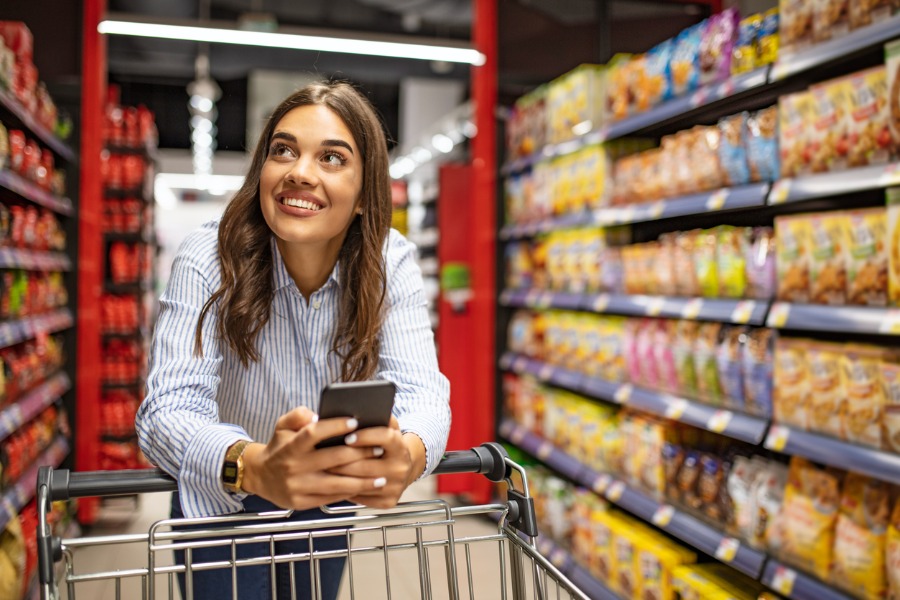Order picking is retrieving items from inventory to fulfill customer orders. Order picking becomes a strategic differentiator in e-grocery, where speed, accuracy, and freshness are non-negotiable.



One of the most important things that retailers need to do is track and adjust to the various factors that affect customers’ grocery shopping behavior and purchasing activities.
This will improve operational efficiency and boost customer satisfaction, leading to brand loyalty and increased revenue.
"On average, consumers shop at grocery stores at least eight times a month, likely at one of the 63,000 grocery stores in the United States."
It is a very competitive industry, but most grocery store owners assume that their businesses will be safe because people will always need food. However, maintaining healthy profits in an ever-changing market is easier said than done.
Several external and internal elements dictate shoppers’ behavior:
The success of a grocery store lies in the knowledge of its market’s purchasing habits and the ability to adjust to their changing preferences.
Some external factors that influence grocery shopping behavior include:
Inflation and supply chain disruptions have reduced supermarket margins to 1% to 3%, according to an Oracle report.
It is more important than ever to attract more customers and encourage more purchases in a challenging economic environment.
Consumers respond strongly to bargains and discounts for essential items. Furthermore, food items near expiry can be sold at lower prices.
Demographic and cultural factors also influence purchasing behavior. For example, Asian households buy a lot of rice, and those who practice Islam always look for Halal products.
Subcultures also promote certain diets, and more and more shoppers look for vegan or organic options. More awareness of food allergies and intolerances has also led to the proliferation of gluten- and dairy-free products.
Another great example is younger audiences primarily use mobile devices to browse and shop online. They are more likely to purchase items through mobile apps instead of websites.
For grocery retailers, knowledge is power. Knowing about these influences makes it easy to stock up on products and ensure diversity and inclusivity in their operations.
Over 158 million people shopped for their groceries online in 2023. In the digital age, your grocery business will be left behind if you don’t have an ecommerce store or mobile app.
Robust grocery mobile apps make it easy for shoppers to find everything they need on one platform. Sending out notifications for new items, promotions, coupons, and discounts can also increase conversions.
Grocery stores have more control over internal factors that affect grocery shopping behavior. Most grocery stores are quite spacious, with many parking spaces.
It is more comfortable for shoppers to buy groceries in supermarkets with extensive inventories.
They want to walk around comfortably with their cart and load their purchases in their vehicles.
According to consumer expert Paco Underhill, around 66% of supermarket purchases are unplanned. Grocery store layouts encourage this—when shoppers are forced to walk around every aisle for their needs, they are more likely to place indulgences in their carts.
What goes on display at the top shelf or bottom shelf matters. Premium items and best sellers should go on the bull’s eye zone—the one at eye level. The kid’s eye zone is a few inches lower and encourages even more purchases.
These considerations also apply to online grocery stores. The user interface must be easy to navigate, with personalized recommendations to encourage more purchases. The website or shopping app must be optimized, have a great and modern UX, and deploy the best tech practices.
Shoppers love discounts, whether they are buying from online or physical stores. Here are some of the most popular grocery promotions that have worked for years:
All consumers go through a multi-step process to determine which products they will purchase while grocery shopping:
Research studies have shown that people buy more food when they are hungry. Food-tasting and sampling booths during lunch and hours could encourage shoppers to put more items in their carts, prompted by the smell of the free food on display.
Research and planning
Most people plan their grocery trips in advance, and their shopping lists are based on their most immediate needs. Most modern consumers look up items online before purchasing, and around 43% use social networks.
Online grocery retailers can leverage email marketing and social media to shape consumer behavior and capture their attention during the research stage.
Brand loyalty and recognition
Brand loyalty is another critical consideration for shoppers in the pre-planning stage. Consumers purchase from brands they already trust and have had previous positive experiences with. This is why customer service must be every retailer’s priority.
Effective online marketing strategies and a consistent, cohesive online presence can boost brand recognition and attract more shoppers.
Despite shoppers' plans, most of their decisions are made in-store. Customers end up purchasing products because of the beautiful packaging or an attractive sale.
In-store experience
Grocery shopping behavior can be influenced by friendly and engaging staff. Proper customer service training for all members of the team can boost sales. Store layout and design have a significant impact, too.
Product packaging and placement
Eye-level product placement and eye-catching promotions are effective tactics to encourage purchases. Items near expiry can be placed on endcap displays at largely reduced prices. Sale items in dump bins will also catch the eyes of impulsive buyers.
The customer experience doesn’t end after the moment of purchase.
Customer feedback and reviews
Contact customers via email, social media, or mobile app and encourage them to provide feedback on their shopping experience.
Loyalty programs
Attractive discounts and promotions for loyal customers will encourage more purchases in the coming months and years.
Share: